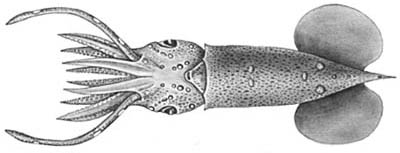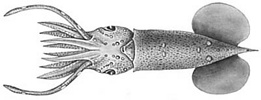Pterygioteuthis gemmata
Richard E. Young and Katharina M. Mangold (1922-2003)Introduction
Pterygioteuthis gemmata and P. microlampas are very similar but are most easily separated by the larger size of P. gemmata and the greater number of hooks on the arms of males of this species (Riddell, 1985).
Characteristics
- Arms
- Hectocotylus (left arm IV) plate with many small teeth.*
image info
Figure. Upper left - P. gemmata toothed plates from the hectocotylus of two males from off California (redrawn from Young, 1972) and from one male from off New Zealand (redrawn from Riddell, 1985). Bottom left - P. microlampas toothed plates from two males from off New Zealand (redrawn from Riddell, 1985). Right - A cleared hectocotylus of P. microlampas from Hawaiian waters showing the toothed plate. Black dots throughout the arm tissue are artifacts. Photograph by R. Young.
 image info
image info Figure. Hectocotylus of P. gemmata, 27 mm ML, off Southern California, toothed plate not visible. Drawing from Young, 1972.
- Arms I, II and III with hooks in ventral series only.*
- 13-28 hooks on combined lateral arms (arms II and III on one side) in either males or females.
- Arms IV of males and females with suckers.* (See drawing to the right of arms IV of a female.)
 image info
image info Figure. Oral views of the left and right ventral arms of P. gemmata, 34 mm ML, 22°N, 124°W. Drawing from Okutani, 1974.
- Hectocotylus (left arm IV) plate with many small teeth.*
- Photophores
- Tentacles each with four embedded photophores.*
- Eye with 10 large and four minute photophores.*
- Size
- Females mature at 26 mm ML.
- Maximum length about 32 mm ML.
Comments
The tentacular club and arm and club suckers are shown here even though species-specific characters have not yet been identified.
Figure. Oral views of tentacular club and club and arm suckers of P. gemmata. Left - Tentacular club, 28 mm ML. Right - Inner sucker rings of the largest arm III sucker (left) and the largest manus sucker (right), 23 mm ML. Drawings from Young, 1972.
Distribution
Vertical Distribution
Off California, P. gemmata was captured mostly at depths of 300-600 m during the day and in the upper 200 m of depth at night (Roper and Young, 1975). Due to the use of open nets and crude depth recorders, these data lack precision.
Geographical Distribution
This species was first described from the South Atlantic (Chun, 1908). It has a broad distribution throughout much of the tropical and temperate regions of the Atlantic Ocean. In the Pacific, it seems to be found in temperate waters only: It is known from waters off Southern California (Young, 1972) and south of about 28° S. (to at least 40° S.) in the waters off New Zealand (Riddell, 1982). At this latter location it barely overlaps with its northern congener, P. microlampas (see distribution of this latter species). The following map shows the general localities (white circles) where P. gemmata has been captured. Localities where pyroteuthids other than this species have been captured are indicated by yellow crosses (records listed here).
Geographical variation
P. gemmata individuals from off California have a mean of 21.1 hooks on the lateral arms (all four arms II and III) while squids from the North Atlantic and New Zealand waters have 15.2 and 15.3 (respectively). Specimens from an unidentified region in the South Pacific, however, have 17.3 hooks (Young, 1972). Squids from New Zealand waters have a hectocotylus plate with usually 10 rather even-sized teeth and those from Californian waters usually have 9 teeth of irregular size (see Figure for character no. 1 above).
At present these population differences simply imply that geographical variation exists.
References
Chun, C. 1910. Die Cephalopoden. Oegopsida. Wissenschaftliche Ergebnisse der Deutschen Tiefsee-Expedition, "Valdivia" 1898-1899, 18: 1-522 + Atlas.
Nesis, K. N. 1982. Abridged key to the cephalopod mollusks of the world's ocean. 385+ii pp. Light and Food Industry Publishing House, Moscow. (In Russian.). Translated into English by B. S. Levitov, ed. by L. A. Burgess (1987), Cephalopods of the world. T. F. H. Publications, Neptune City, NJ, 351pp.
Okutani, T. 1974. Epipelagic decapod cephalopods collected by micronekton tows duringthe EASTROPAC expeditions, 1967-1968 (systematic part). Bull. Tokai Reg. Fish. Res. Lab., 80: 29-118.
Riddell, D. J. 1985. Enoploteuthidae of the New Zealand Region. Fisheries Research Bulletin. New Zealand Ministry of Agriculture and Fisheries, No.27: 1-52.
Roper, C. F. E. and R. E. Young. 1975. Vertical distribution of pelagic cephalopods. Smithsonian Contributions to Zoolog, 209: 1-51.
Young, R. E. 1972. The systematics and areal distribution of pelagic cephalopods from the seas off Southern California. Smithson. Contr. Zool., 97: 1-159.
Title Illustrations
| Scientific Name | Pterygioteuthis gemmata |
|---|---|
| Reference | from Young, R. E. 1972. The systematics and areal distribution of pelagic cephalopods from the seas off Southern California. Smithson. Contr. Zool. 97:1-159. |
| Copyright | © 1972 Richard E. Young |
About This Page
Richard E. Young
Dept of Oceanography
University of Hawaii
Honolulu, Hawaii 96822
USA
Katharina M. Mangold (1922-2003)
Page copyright © 1996 Richard E. Young and Katharina M. Mangold (1922-2003)
Citing this page:
Young, Richard E. and Mangold (1922-2003), Katharina M. 1996. Pterygioteuthis gemmata . Version 01 January 1996 (under construction). http://tolweb.org/Pterygioteuthis_gemmata/19750/1996.01.01 in The Tree of Life Web Project, http://tolweb.org/










